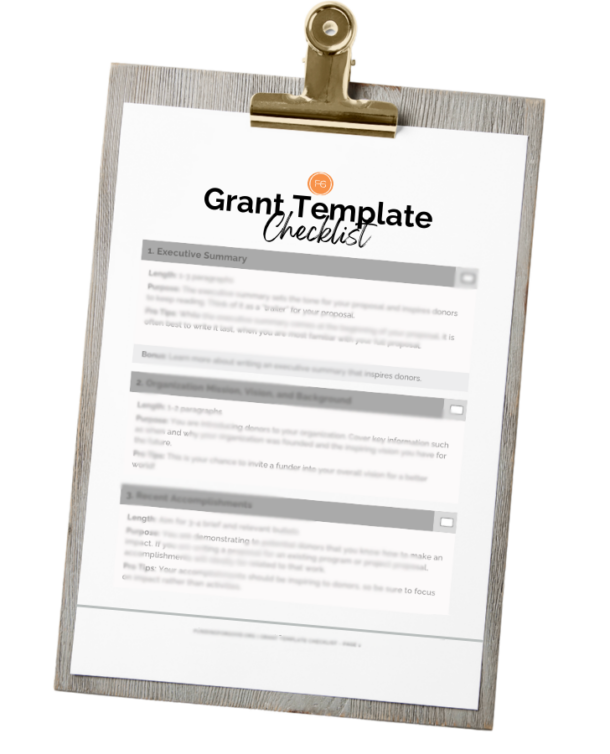Everywhere we go, nonprofit staff and board members tend to tell us the same thing…” We are looking to hire a successful grant writer.” They don’t always know how the board is useful in the grant winning process.
If your organization is established enough to invest in a qualified grant writer, then “Kudos” to you. If you are hoping to hire a grant writer as a last “Hail Mary” for your floundering organization, then today’s topic is for you.
More often than not, staff and board members who seek to hire a “grant writer” assume that a professional will be able to bring in the dollars. Armed with only their paper and pen or laptop and printer, they should print money! However, there is more to the grant writing and grant winning process.
Before we dive into the board’s role in the grant winning process, it is important to understand the grant writer’s role. A grant writer, whether you opt for someone in-house or a professional contractor, is simply a tool many nonprofits utilize to achieve fundraising goals. Some grant writers are experienced and a better match for the job than some of the other tools you might have at your disposal. However, grant writers cannot function independently. They cannot invent data or get creative with the proposal process. A Grant Writer can’t seek funding for programs/projects that have not been approved, or even authorize the submission of a proposal without authorization from the organization’s key executives.
At the end of the day, the grant writer and grant winning process will only be as successful as your organization’s leadership!
Whether your nonprofit is currently writing grants in-house or toying with the idea of hiring a professional, make sure your board of directors understands how their engagement directly impacts the organization’s ability to submit and secure grants successfully.
Top 6 Ways Your Board Contributes to the Grant Writing Process:
- Adopt a strategic plan that includes short-term and long-term goals.
Donors view their grant dollars as an investment. Many donors will even request a copy of your organization’s strategic plan to confirm that the program/project you are proposing truly does contribute to your mission and long-term impact goals. While your staff and board could and should be active participants in this process, one of the board’s primary governance functions is to establish a clear direction for the organization in the coming years. As such, the board is responsible for spearheading and approving a strategic plan. Lack of a board-approved strategic plan can kill even the highest quality proposal’s chance of getting awarded.
- Approve a Development Plan
Many organization’s focus on “fundraising” for dollars. A comprehensive development plan is vital for achieving all capacity building goals, whether they are related to dollars, personnel, or other resources. The best development plans are based on realistic budgets for the current and upcoming fiscal years and include a variety of funding streams. These funding streams may include contributions from individuals, support from local businesses, sponsorships, planned giving, annual campaigns, special events, and grants. If grants are included in that plan, the board needs to ensure that all the systems are in place to ensure successful grant processes and that there are dollars in the budget to pay for services if needed.
It is unethical to expect a professional grant-writer to work “on a commission basis” which means you need dollars in hand to pay for all services rendered. Almost every single grant application requires the applicant to describe their succession plan. If the writer cannot describe how the organization will sustain the program/project beyond the grant cycle, the proposal will most likely be rejected!
- Ensure Grant-Writing Systems are in Place
- Before a grant can be written, the organization must first identify key needs, program/project timelines, and prospective supporters beyond grant foundations. Grantors will most often require that proposals include the total project amount as well as a detailed list of what other support has been secured towards the project! One of the board’s key functions is to actively support fundraising efforts which include prospecting and soliciting support. As the board secures potential and confirmed donors, it is important to share those with staff and the grant writer so proposals are more competitive!
- If an organization is “volunteer-led” then it is crucial for the board to identify who will be the primary contact for the grant writer. The authorized representative should be able to provide key information related to the organization’s history, details of current and future programs or projects, partnership agreements, key impact data, and current financial reports. In addition to providing the approved operating budget, your board treasurer might need to help the grant writer gain access to other key documents such as income and expense reports, audits, 990s and more.
- Ensure the grant writer and authorized representatives have systems in place to identify grant prospects, complete proposals, review proposals prior to submission, and secure the required signatures from the board chair, treasurer, or other approved executive leader.
- Maintain an Active and Diverse Board
Believe it or not, almost EVERY single grant application requires the applicant to provide detailed information about the board of directors. At the end of the day, a staff member can resign or be terminated, but the board of directors remains the governing body of the organization. It is not uncommon for donors to deny grants to worthy projects simply because the applicant’s board of directors was extremely small, was comprised only of the founder’s family members, was inexperienced, or lacked diversity. Even the most successful grant writer cannot compensate for a weak board!
- Contribute Financially
Every single board member should be supporting the organization financially at the leadership level. Donors often require applicants to provide detailed responses to the following questions:
“What percentage of your board contributes to the organization annually?”
“What is the total dollar amount that your board contributed this/last fiscal year?”
“What percentage of the total organizational budget represents financial contributions from your board?”
- Be Informed
It is impossible for a board to contribute to a process that the individual members do not understand. Below you will find Funding for Good’s Top 10 List of What Every Board Member Should Know About the Grant Writing Process.
Quick Facts About Grants
- A healthy organization should never be more than 30% dependent on grant funds for general operating expenses.
- Grants are NOT a way to generate sustainability but rather support capacity building and new initiatives.
- Grants can take 6-9 months to secure from the time you complete research, identify a prospect, begin building a relationship with the foundation, craft and submit a proposal, await award notifications and finally receive a check!
- Even the highest quality proposals might not be selected for funding.
- Grants are never guaranteed from year to year
- Grants that support project materials but not staff salaries and overhead often create a burden on organizations that are not prepared for the increased workload and/or salary increases needed to implement and complete the project successfully.
- Most grants are part of a competitive grant cycle. Just because your organization is “encouraged to apply” does NOT mean you will receive funding.
- You must be prepared to modify project design and fundraising strategies should you only receive partial funding.
- Most grant proposals require that you include a sustainability plan to ensure that the program/project can continue after grant funds expire.
- Many grant proposals require that the organization share the percentage of board members who contribute financially to the organization annually.
At the end of the day, “donors want to fund your IMPACT, not your EXISTENCE” (Beth Brodovsky).
Donors now more than ever are looking beyond that “perfect proposal” to determine if the applicant organization has the leadership and capacity to fulfill all listed goals and objectives.
It the board’s job to ensure that your grant writer can truthfully say “Our proposal aligns with the organization’s approved strategic plan and is being submitted with the knowledge and full support of our board of directors.”
As always, check out our Upcoming Events Page and our Free Stuff Page. If we can help you with Board Solutions or Grant Related services, just let us know. Keep Growing for Good!


